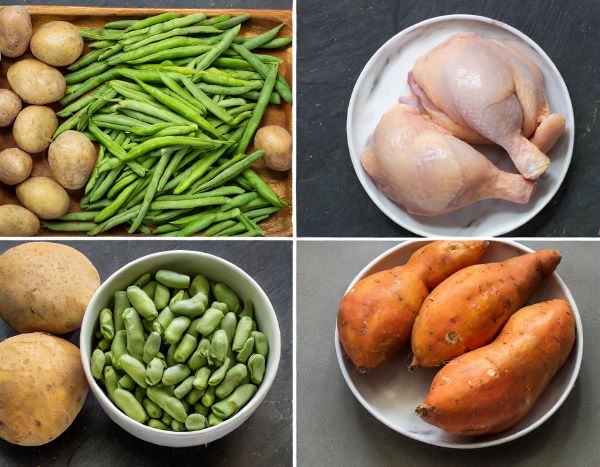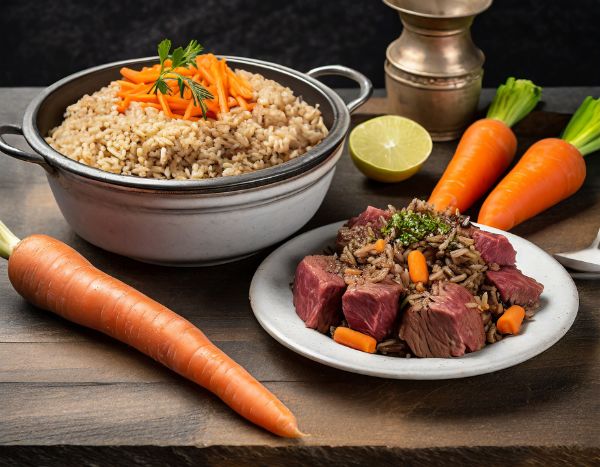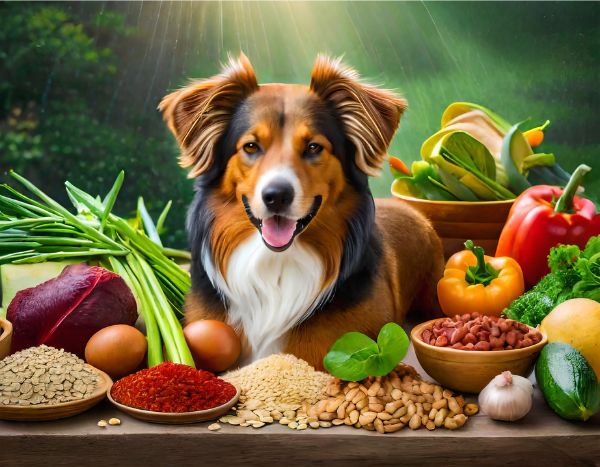Hello, conscious pet parents! Today, we’re diving into the world of organic dog food, exploring the myriad of benefits it brings to our furry friends and the environment. But what exactly does “organic” mean when it comes to pet food, and why is it worth considering? Let’s unravel these questions and discover how to provide our dogs with wholesome, organic meals.
Organic Dog Food Recipes
Organic Chicken and Veggie Mix

Ingredients:
- Organic Chicken: Opt for free-range or pasture-raised organic chicken to ensure you’re getting the highest quality meat free from antibiotics and hormones.
- Sweet Potatoes: A fantastic source of fiber, sweet potatoes also pack a punch of vitamins A, C, and B6.
- Green Beans: These veggies are low in calories but high in essential nutrients like iron, calcium, and vitamins B and K.
Instructions:
- Prepare the Chicken: Start by thoroughly cooking the organic chicken until it’s well-done. Ensure there are no pink parts left to guarantee it’s safe for your dog to eat.
- Steam the Veggies: While the chicken is cooking, steam the sweet potatoes and green beans until they are soft. Steaming helps to retain more nutrients compared to boiling.
- Mix Together: Once everything is cooked, chop the chicken and veggies into bite-sized pieces suitable for your dog’s size. Mix them together, ensuring an even distribution of chicken and veggies.
Benefits:
This Organic Chicken and Veggie Mix is a powerhouse of nutrition. The organic chicken provides a high-quality source of protein, essential for muscle growth and repair. Sweet potatoes contribute a healthy dose of fiber, aiding in digestion, while green beans offer a variety of vitamins and minerals, supporting overall health. This meal is not just a treat for your dog’s taste buds but also a boost to their well-being.
Organic Beef and Brown Rice

Ingredients:
- Organic Beef: Choose lean cuts of organic beef to provide your dog with a rich source of protein.
- Brown Rice: A whole grain option, brown rice offers fiber and essential nutrients.
- Carrots: Packed with beta-carotene, vitamins, and minerals, carrots are a crunchy, nutritious addition.
Instructions:
- Brown the Beef: In a pan, cook the organic beef until it’s thoroughly browned. Make sure to drain any excess fat.
- Cook the Rice: In a separate pot, cook the brown rice according to the package instructions.
- Steam the Carrots: Steam the carrots until they are soft, making them easier for your dog to digest.
- Combine: Once everything is cooked, chop the beef and carrots into bite-sized pieces and mix them with the brown rice. Ensure a good mix for even distribution of ingredients.
Nutritional Info:
This Organic Beef and Brown Rice recipe is a balanced and nutritious option for your furry friend. The organic beef serves as an excellent source of protein, while the brown rice provides fiber for healthy digestion. Carrots add a crunch and are a natural source of vitamins and minerals, contributing to your dog’s overall health. This meal is a wholesome choice, ensuring your dog gets the nutrients they need without any added chemicals or preservatives.
These organic recipes are not just a treat for your dog; they are a step towards a healthier, happier life. Enjoy the peace of mind that comes with feeding your furry friend high-quality, nutritious meals.
Why Choose Organic?

Health Benefits Galore
Opting for organic dog food isn’t just a trend; it’s a conscious choice towards a healthier lifestyle for your furry companion. Here’s why it makes a difference:
- Fewer Allergens: Organic dog food is often crafted with fewer ingredients, reducing the risk of allergens that can cause irritations and allergies in sensitive pups.
- Less Exposure to Pesticides: By choosing organic, you’re opting for ingredients that are cultivated without the use of harmful pesticides. This means your dog is less likely to ingest these potential toxins, leading to a healthier, happier life.
A Nod to Mother Earth
But the benefits don’t stop at health; choosing organic is also a vote for a healthier planet.
- Sustainable Farming: Organic farming practices are all about sustainability. They promote soil health, biodiversity, and a balanced ecosystem, ensuring that we are taking care of our planet for future generations.
- Reduced Chemical Runoff: Traditional farming methods often involve a plethora of chemicals, leading to runoff that can contaminate our water sources. By choosing organic, you’re helping to reduce this runoff, contributing to cleaner water and a healthier environment.
Choosing organic dog food is a step towards a healthier lifestyle for your pet and the planet. It’s about making informed choices, understanding the impact of those choices, and striving for a world where our pets and our environment can thrive together.
Top Organic Ingredients for Dogs
The Cream of the Crop

When it comes to feeding your furry friend, choosing the right ingredients is crucial. Here’s a guide to the top organic options:
- Organic Meats: Prioritize meats that are free from antibiotics and growth hormones. Options like organic chicken, beef, or turkey are excellent protein sources for your dog.
- Organic Vegetables: Vegetables are a great way to add fiber and essential nutrients to your dog’s diet. Opt for organic options like carrots, sweet potatoes, and green beans, which are grown without synthetic pesticides or fertilizers.
Sourcing Your Ingredients
Knowing where to find these top-notch ingredients is half the battle. Here’s where to look:
- Farmers’ Markets: These local gatherings are goldmines for fresh, organic produce. You’ll find a variety of fruits and vegetables, and you can feel good knowing you’re supporting local farmers.
- Certified Organic Brands: When shopping for pre-made organic dog food or ingredients, look for brands that carry official organic certification. This ensures that the products meet strict standards and are genuinely organic.
Choosing organic ingredients for your dog’s meals is a step towards a healthier, happier pet. With the right sources and a keen eye for quality, you can provide your furry friend with the best that nature has to offer.
Tips for Transitioning to Organic

Taking it Slow
Switching your dog’s diet to organic food is a commendable decision that can lead to numerous health benefits. However, it’s a process that should be approached with care and attention to ensure a smooth transition for your furry friend. Here’s how to do it right:
- Gradual Change: Just like us, dogs have sensitive digestive systems, and a sudden change in diet can lead to discomfort or even health issues. To avoid this, start by introducing the organic food gradually. Mix a small amount of the new organic food with their current food, and slowly increase the organic portion while decreasing their regular food over a period of 7-10 days. This method helps their digestive system adjust to the new ingredients without causing distress.
- Observe Your Dog: As you make this transition, it’s crucial to observe your dog’s reaction to the change. Pay attention to their energy levels, stool consistency, and overall behavior. If you notice any signs of digestive upset, such as diarrhea or vomiting, it might be necessary to slow down the transition process even further. Every dog is unique, and some may take more time to adjust than others.
- Consult with a Veterinarian: If you’re ever in doubt or if your dog has specific health issues, it’s always a good idea to consult with a veterinarian. They can provide guidance tailored to your dog’s individual needs and help ensure that the transition to an organic diet is a safe and beneficial one.
Embracing an organic diet for your dog is a positive step towards enhancing their well-being. By taking it slow and staying attentive to your dog’s needs, you can make the transition seamless, paving the way for a healthier and happier life for your pet.
Addressing the Cost of Organic

Feeding Organic on a Budget
Opting for organic dog food is a fantastic choice for your pet’s health and the environment, but many pet owners are concerned about the cost. Here are some strategies to feed your dog organic without breaking the bank:
- Buy in Bulk: One of the most effective ways to save money on organic dog food is to buy in bulk. Many stores offer discounts for larger quantities, and this can significantly reduce the cost per serving. Look for reputable suppliers that offer organic ingredients in bulk.
- DIY Treats: Instead of spending money on expensive organic treats, why not make your own at home? There are plenty of simple and healthy recipes available that require just a few organic ingredients. Not only is this cost-effective, but it also allows you to know exactly what’s going into your dog’s treats.
Weighing the Benefits Against the Cost
While organic dog food can be more expensive upfront, it’s important to consider the long-term benefits:
- Long-Term Health: Feeding your dog a high-quality, organic diet can contribute to their overall health and may prevent certain health issues, potentially leading to fewer vet bills in the future. A healthier diet can contribute to a longer, happier life for your pet.
- Environmental Impact: Choosing organic isn’t just good for your dog; it’s also a vote for sustainable farming practices. Organic farming reduces chemical runoff, promotes biodiversity, and contributes to soil health. By choosing organic, you’re playing a part in supporting these environmentally friendly practices.
Investing in organic dog food is an investment in your pet’s health and the health of the planet. With smart shopping strategies and a bit of DIY, it’s possible to provide your furry friend with a high-quality organic diet without overspending. Remember, the benefits of a healthier life and a cleaner environment are well worth the cost.
FAQ About Organic Dog Food Recipes

Navigating the world of organic dog food can be tricky, and we know you have questions. Below, we’ve compiled answers to some of the most commonly asked questions to help guide you towards making the best choices for your furry friend’s diet.
What are the best ingredients for homemade dog food?
When it comes to whipping up homemade dog food, choosing the right ingredients is crucial. Here are some top picks:
- Proteins: Opt for lean meats like chicken, turkey, and beef. Ensure they are cooked well and are free from any seasoning or additives.
- Vegetables: Incorporate a variety of vegetables such as carrots, peas, and sweet potatoes. Make sure they are cooked and chopped to a digestible size.
- Carbohydrates: Brown rice and quinoa are excellent sources of energy and are easy on your dog’s digestive system.
Remember, balance is key, and it’s crucial to consult with a veterinarian to ensure your homemade recipes meet all of your dog’s nutritional needs.
What should the top 3 ingredients be in dog food?
The top three ingredients in your dog’s food play a significant role in their overall nutrition. Look for:
- A High-Quality Protein Source: This should be the first ingredient listed and could be chicken, beef, or lamb.
- Whole Vegetables or Fruits: These provide essential vitamins, minerals, and fiber.
- Whole Grains or Other Healthy Carbohydrates: Brown rice or sweet potatoes are great options for providing energy and aiding in digestion.
Always opt for whole, unprocessed ingredients to ensure your dog is getting the most nutritional value from their food.
What are biologically appropriate dog food recipes?
Biologically appropriate dog food recipes are formulated to match the natural diet of dogs in the wild. These recipes typically include:
- A Variety of Proteins: Including different types of meat, organs, and even bones.
- Limited Carbohydrates: Dogs in the wild wouldn’t have access to high levels of carbohydrates, so these should be minimized.
- No Artificial Additives: Everything in the recipe should be natural and beneficial for your dog’s health.
These recipes aim to provide a balanced, nutrient-dense diet that supports your dog’s natural biological needs. Always consult with a veterinarian before transitioning your dog to a biologically appropriate diet to ensure it’s suitable for their specific health needs.
We hope these answers help clear up any confusion and guide you towards making the best nutritional choices for your furry friend. Remember, every dog is different, and what works for one may not work for another, so it’s always best to consult with a veterinarian when making significant changes to your dog’s diet.
Conclusion: That Was the Organic Dog Food Recipes

Embracing organic dog food is a step towards ensuring the health and well-being of our beloved pets, while also making a positive impact on the environment. It’s about making thoughtful, informed choices, understanding the benefits, and finding ways to make it work within our budgets. So, here’s to happy, healthy pups and a cleaner, greener planet! Cheers to organic goodness and wagging tails!
More helpful posts!
If this post was helpful to you then these ones might be perfect for you:

